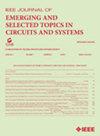Do We Need 10 bits? Assessing HEVC Encoders for Energy-Efficient HDR Video Streaming
IF 3.8
2区 工程技术
Q2 ENGINEERING, ELECTRICAL & ELECTRONIC
IEEE Journal on Emerging and Selected Topics in Circuits and Systems
Pub Date : 2025-01-23
DOI:10.1109/JETCAS.2025.3533041
引用次数: 0
Abstract
High-dynamic range (HDR) video content has gained popularity due to its enhanced color depth and luminance range, but it also presents new challenges in terms of compression efficiency and energy consumption. In this paper, we present an in-depth study of the compression performance and energy efficiency of HDR video encoding using High-Efficiency Video Coding (HEVC). In addition to using a native 10-bit HDR encoding configuration as a reference, we explore whether applying tone mapping to an 8-bit representation before encoding can result in additional bitrate and energy savings without compromising visual quality. The main contributions of this work are as follows: 1) a detailed evaluation of four HDR video encoding configurations, three of which leverage tone mapping techniques, 2) a comprehensive experimental setup involving over 15,000 individual encodings across three open-source HEVC encoders (Kvazaar, x265, and SVT-HEVC) and multiple presets, 3) the use of two advanced perception-based metrics for BD-rate calculations, one of which is specifically tailored to capture colour distortions and 4) an open-source dataset consisting of all experimental results for further research. Among the three tone-mapping configurations tested, our findings show that a simple bit-shifting approach can achieves significant reductions in both bitrate and energy consumption compared to the native 10-bit HDR encoding configuration. This research aims to lay an initial foundation for understanding the balance between coding efficiency and energy consumption in HDR video encoding, offering valuable insights to guide future advancements in the field.我们需要10位吗?评估高效节能HDR视频流的HEVC编码器
高动态范围(HDR)视频内容因其增强的色彩深度和亮度范围而受到欢迎,但它也在压缩效率和能耗方面提出了新的挑战。本文采用高效视频编码(High-Efficiency video Coding, HEVC)技术对HDR视频编码的压缩性能和能效进行了深入研究。除了使用原生10位HDR编码配置作为参考外,我们还探讨了在编码之前将色调映射应用于8位表示是否可以在不影响视觉质量的情况下节省额外的比特率和能源。本工作的主要贡献如下:1)对四种HDR视频编码配置进行详细评估,其中三种利用色调映射技术;2)在三个开源HEVC编码器(Kvazaar, x265和SVT-HEVC)和多个预设中涉及超过15,000个单独编码的综合实验设置;3)使用两个基于感知的高级指标进行bd率计算;其中一个是专门为捕获颜色失真而定制的,4)一个由所有实验结果组成的开源数据集,用于进一步研究。在测试的三种色调映射配置中,我们的研究结果表明,与原生10位HDR编码配置相比,简单的位移位方法可以显著降低比特率和能耗。本研究旨在为理解HDR视频编码中编码效率和能耗之间的平衡奠定初步基础,为指导该领域的未来发展提供有价值的见解。
本文章由计算机程序翻译,如有差异,请以英文原文为准。
求助全文
约1分钟内获得全文
求助全文
来源期刊

IEEE Journal on Emerging and Selected Topics in Circuits and Systems
ENGINEERING, ELECTRICAL & ELECTRONIC-
CiteScore
8.50
自引率
2.20%
发文量
86
期刊介绍:
The IEEE Journal on Emerging and Selected Topics in Circuits and Systems is published quarterly and solicits, with particular emphasis on emerging areas, special issues on topics that cover the entire scope of the IEEE Circuits and Systems (CAS) Society, namely the theory, analysis, design, tools, and implementation of circuits and systems, spanning their theoretical foundations, applications, and architectures for signal and information processing.
 求助内容:
求助内容: 应助结果提醒方式:
应助结果提醒方式:


